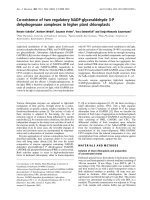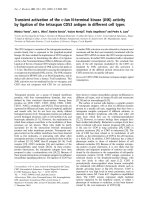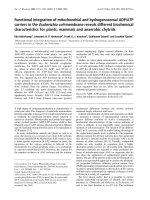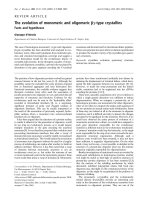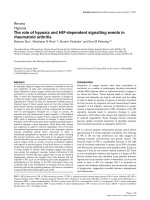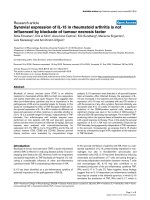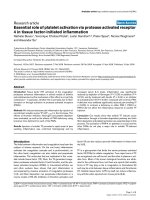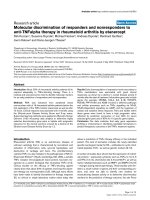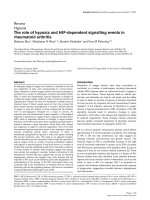Báo cáo y học: "Chaotic nature of sepsis and multiple organ failure cannot be explained by linear statistical methods" ppt
Bạn đang xem bản rút gọn của tài liệu. Xem và tải ngay bản đầy đủ của tài liệu tại đây (32.25 KB, 1 trang )
Page 1 of 1
(page number not for citation purposes)
Available online />Severe sepsis and septic shock represent a major cause of
mortality in critical care. Even in patients who survived, a
clinical course complicated with multiple organ dysfunction
leads to significant morbidity, costs, and use of already
limited resources. That’s why treatment of these patients
requires timely mobilization of a logical and scientifically up-
to-date plan.
In critical care, as in almost all disciplines of medicine, the
emphasis on the benefits of an evidence-based medicine
approach has caused current guidelines to be based mostly
on the results of prospective randomized clinical studies [1].
These studies mostly evaluate differences in mortality among
treatment arms.
But sepsis and multiple organ failure have a chaotic nature,
and treatment effects cannot be explained solely on the basis
of differences in mortality. That’s why we believe that the
linear statistical methods currently used in clinical research
are not enough to model this chaotic nature.
Besides the complex pathophysiologic interactions within
inflammatory cascade and coagulation, a genetically deter-
mined predisposition for sepsis and septic shock is another
reason that diverts the clinical course of sepsis and septic
shock from one that is linearly predictable. Additionally, there
is a temporal and dynamic relationship between failing organ
systems and therapeutic interventions [2]. It is not unusual to
see a patient present to the intensive care unit with a 10%
predicted mortality and die whereas a patient who has an
85% predicted mortality survives.
On the basis of these observations, we believe that currently
used statistical methods using mortality as an endpoint to
measure a difference between therapeutic arms are not
sufficient to explain the chaotic nature of severe sepsis and
septic shock. We believe that statistical methods used in
industrial engineering and economics, like time series
analysis and forecasting, must be adapted and used for
clinical studies among this patient group.
Competing interests
YAK is the director of Bilgitay Study Group and the Muavenet
Intensive Care Information System, which is an open access,
online academic information system. The other authors
declare that they have no competing interests.
References
1. Dellinger RP, Levy MM, Carlet JM, Bion J, Parker MM, Jaeschke R,
Reinhart K, Angus DC, Brun-Buisson C, Beale R, Calandra T,
Dhainaut JF, Gerlach H, Harvey M, Marini JJ, Marshall J, Ranieri M,
Ramsay G, Sevransky J, Thompson BT, Townsend S, Vender JS,
Zimmerman JL, Vincent JL; International Surviving Sepsis Cam-
paign Guidelines Committee; American Association of Critical-
Care Nurses; American College of Chest Physicians; American
College of Emergency Physicians; Canadian Critical Care
Society; European Society of Clinical Microbiology and Infectious
Diseases, et al.: Surviving Sepsis Campaign: international
guidelines for management of severe sepsis and septic
shock: 2008. Crit Care Med 2008, 36:296-327.
2. Kilic YA, Yorganci K, Sayek I: Visualizing multiple organ failure:
a method for analyzing temporal and dynamic relations
between failing systems and interventions. Crit Care 2007, 11:
417.
Letter
Chaotic nature of sepsis and multiple organ failure cannot be
explained by linear statistical methods
Sarah Saliba
1
, Yusuf Alper Kilic
2
and Selman Uranues
1
1
Universitätsklinik für Chirurgie, Sektion für Chirurgische Forschung Auenbruggerplatz 29, 8036 Graz, Austria
2
Hacettepe University Faculty of Medicine Department of General Surgery, 06100, Hacettepe Ankara, Turkey
Corresponding author: Yusuf Alper Kilic,
Published: 22 April 2008 Critical Care 2008, 12:417 (doi:10.1186/cc6856)
This article is online at />© 2008 BioMed Central Ltd
